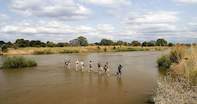
For a true wilderness experience there is nothing to beat a walking safari. Leave behind the distracting sounds and smells of vehicle or boat engines; enjoy the freedom of exploring at will, away from the restrictions of tracks that scar the landscape.
As you follow your guide into the bush, the senses instantly become heightened, you feel connected with the surrounding environment and you savour the excitement of encounters with wildlife first hand.
On foot you quickly become attuned to the natural signals of the bush: the smell of wild thyme as you brush past; the shrill alarm call of a puku, suggesting the presence of a leopard nearby; the rustle of hundreds of tiny wings as a flock of quelea pass overhead.
There is nothing more thrilling than walking in the open near to big game, close enough to hear the rumble of an elephant's stomach. Walking safaris recapture the spirit of the golden days of safari, when it was down to the experience, bushcraft and intuition of your guide and tracker to locate and approach animals.
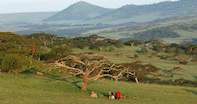
The relationship that you have with your guide defines any safari, but never are a guide's abilities more critical than when you are walking in the bush, both for safety and the wealth of information he or she can pass on. In the company of Africa's best guides - the likes of Gavin Ford in Botswana, Robin Pope in Zambia or John Stevens in Zimbabwe - your safari becomes a riveting journey of discovery as layer after layer of the natural world is unveiled.
On a walk you have time to examine termite mounds, peer down spiders' holes and learn about the medicinal properties of plants and trees. You may, admittedly, see fewer large animals - they recognise humans on foot as a threat and tend to be more skittish - but you will appreciate far more about the fascinating web of relationships that make up the natural world.
Many lodges and camps throughout Africa offer half-day walks locally, but for the purpose of this review we have focused largely on areas where you can make a journey in the true sense of safari, travelling on foot from place to place, staying either in a series of permanent lodges or at fly-camps.
By their nature, walking safaris tend to take you to Africa's wildest and least developed wildlife areas. We have recommended some of the very best, ranging as far afield as the community reserves of northern Kenya, the vast Selous Reserve in southern Tanzania, the Zambezi Valley, the Okavango Delta and Zambia's Luangwa Valley - regarded by many as the home of the modern walking safari.
These walks are about savouring nature up close and personal, unhurried, undisturbed, unspoilt. They are not endurance hikes. Distances covered are not huge and you rarely carry more than a camera, binoculars and suncream. Your luggage miraculously appears at the next camp, where your shower and a welcome meal are guaranteed. For your own safety, it's vital to do as your guide instructs at all times; and for the love of Africa, follow the conservationists' maxim: "take only memories, leave only footprints".
Zambia
South Luangwa
In 1866, David Livingstone crossed the Luangwa River in what is now South Luangwa NP and declared: "I will make this land better known to men that it may become one of their haunts. It is impossible to describe its luxuriance." Famous for big herds, the park is considered one of the world's greatest wildlife sanctuaries: the concentrations of game near the river and oxbow lakes are rewarding, and there are over 400 bird species.
The flat-bottomed valley is 700km long by an average of 100km wide. It lies 800m below the surrounding plateau and is an extension of the Great Rift Valley. Mineral -rich alluvial flood plains are covered with mopane woodlands and open grasses giving onto distant blue hills. There are two distinct seasons: dry, bare bushveld in winter (May - November) and lush greenery in the wet summertime (December -April).
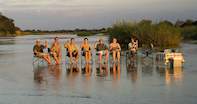
After a walking safari with Robin Pope South Luangwa
The walking safari originated here, first run in the 1950s by conservation champion Norman Carr. The park still offers some of Africa's finest walking, and travel on foot remains the best way to experience this landscape. Unsurprisingly, there's an excellent choice of operators to walk with, including some classic names in the field.
Robin Pope Safaris have built their considerable reputation around walking, operating five-day trails covering around 10km/day, following the clear Mupamadzi River in the remote north of the park. "From ants to buffalo, birds' nests to lion tracking," clients learn the bush, sleeping in fully serviced mobile camps.
Walking safari with Norman Carr in South Luangwa
Or try a three-day walk through Nsefu saltpan, one of Luangwa's best riverine areas.
Until his death in 1996, Norman Carr spent over 50 years devoting himself to the development of the South Luangwa. Norman Carr Safaris now run Kapani Lodge, complemented by four walking bushcamps.
The Bushcamp Company also has four small, exclusive camps, each with a
capacity of six people, offering seven-day walking safaris between them. The facilities are plush: luxuries include hot and cold running water, four-poster double beds and flushing toilets.
Remote Africa, run by John Coppinger, offer four-day trails between remote camps, while Shenton Safaris run walking trails in the pretty area between the rustic Kaingo and Mwamba camps, with easy access to Lion Plain and the scenic Fish Eagle Lagoon. Unique Selling Point (USP): The "home" of the walking safari.
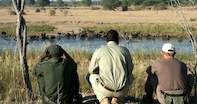
North Luangwa
Further north along the valley lies North Luangwa NP, remote and exclusive. Every cliché about timeless Africa is true here: the park doesn't cater for independent travellers, with no permanent lodges and very few roads. You're unlikely to encounter anyone else during a visit.
Its landscape is an extension of that in South Luangwa, with mopane woodland, riverine forest, grasslands and acacia thickets. The park is cut by the Mwaleshi river, which attracts game and flows over the escarpment in a series of impressive falls (a visit makes a great day trip). The park has a wide range of mammals and birds, and is especially noted for its large buffalo herds, plus accompanying lion.
There are no mobile fly-camp walking safaris in North Luangwa, but the day walking from base camps (between June and October) is exceptional. Robin Pope's trails are based from the grass-pole Kutundala camp, including a visit to the dipping pools at Chipopopma Falls.
Remote Africa run Mwaleshi camp, another grass-pole camp, by the waters of the clear perennial river. The most colourful story in North Luangwa belongs to Mark Harvey, grandson of the indefatigable Sir Stewart Gore-Browne (who built Shiwa N'gandu - The Africa House - in the 1920s). Mark brings over 20 years' local experience to Shiwa Safaris. USP: Exclusivity: few people visit North Luangwa.
Botswana
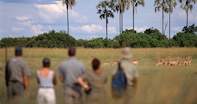
Selinda
Time-worn trails span this private wildlife reserve in the mighty game country of northern Botwana. Centred on the Selinda Spillway, the seasonal channel connecting the Okavango Delta to the Linyati swamps, an area has been set aside for walking safaris. Walks generally last five days, starting at one of the two permanent luxury camps, Selinda or Zibalianja, fly-camping in between and finishing at the other camp.
Usually there are only four guests, who enjoy hot bucket showers and flush toilets after a day's exploring. A Bushman tracker leads guests through the riparian forest, palm-studded grass plains and reed-fringed lagoons, explaining the minutiae of the bush and the skills and lore of his people, as well as tracking big game.
Lion are prolific, living alongside specialist swamp dwellers such as lechwe and sitatunga. After covering 6 - 8km during the morning, guests can put their feet up at the next camp before a 4km sunset walk. USP: Bushman insider knowledge.
Okavango Delta
This mosaic of grassy plains, wooded islands, papyrus-lined channels and open lagoons provides a magical, convoluted labyrinth to explore by foot. Part of the northern Kalahari, the Delta supports one of the continent's greatest and most diverse concentrations of wildlife, as well as over 1000 types of plant (more than any other similar-sized park in Africa).
Reed beds and stands of tall palms are characteristic, and the cool wooded copses include mopane, rain, sausage and acacia trees. Over 400 avian species have been recorded, from tiny water birds to powerful raptors.
When water gets in the way of your walking (as it often does, especially when the seasonal floods from Angola's summer rains trickle down into the Delta), there's no need to disturb the peace of your journey: simply jump into a traditional dugout mokoro and pole over to the next island to continue your journey by foot.
Abercrombie and Kent are fortunate enough to be able to offer the services of inspirational guide Gavin Ford to walking clients based at their opulent Delta camps (Chief's and Stanley's) or on their mobile safaris, either in the Okavango or at Nxai Pan to the east.
Botswana veterans Ker & Downey emphasise an understanding of the Delta through a four-day walking programme tinged with a strong dose of nostalgia for the romance of early bush travel. Due to the diversity of the ecosystem, say Ker & Downey, there's no need to cover large distances to have a rewarding experience.
Landela also offer a gentle four-night walking trail between camps as part of their Delta package, with several opportunities to give legs a rest on a tranquil mokoro ride. USP: Unparalleled patchwork of land and water.
Zimbabwe
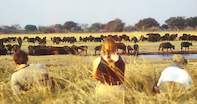
Mana Pools National Park
Flanked by the undulating, blue-mauve Zambezi escarpment and the wide, glassy waters of the Zambezi river, Mana Pools NP clearly deserves its UNESCO World Heritage status. Its ecosystem is unique: open alluvial flood plains, jesse scrub, sweet grasslands and mixed woodlands of acacia and giant mahogany, all teeming with wildlife (including over 12,000 elephant, 8000 buffalo, numerous predators and prolific birdlife).
The park is open during Zimbabwe's dry season (April - November) and is another venue where you're spoilt for choice with top-class walking safari specialists. Typically they operate from comfortable mobile camps on the banks overlooking the water (expect bucket showers, long-drops and great home cooking).
Dinner alfresco by the Zambezi is undoubtedly one of the finest ways to round off a day's walking anywhere in Africa. John Stevens is widely regarded as one of Zimbabwe's top professional guides. He leads private parties of 2-10 people for a minimum of five nights. Also recognised among Zimbabwe's best is Ivan Carter, who hosts walking safaris from his Vundu camp in Mana.
Natureways boast 12 years experience of exploring the Zambezi flood plains, while Classic Africa offer three-night walks through remote, game-rich areas, with itineraries tailored to the group's wishes. USP: Mesmerising Zambezi Valley scenery.
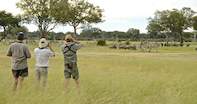
Matusadona National Park
Matusadona NP, reputed to contain Africa's second-largest concentration of lion, is the place if you want challenging, adrenalin-filled walks. The rugged hills of the Zambezi Escarpment rise above the seemingly endless southern shoreline of Lake Kariba. The waterside grasslands provide an ideal leonine habitat, with large herds of buffalo (up to 1000) and impala as prey.
Prides of up to 30 lion are not unusual. Elephant are also common and Black rhino linger at the foot of the escarpment. The park is flanked by the verdant valleys of the Ume and Sanyati rivers, both partially flooded by lake water. Mopane scrub, dense jesse bush and ghostly drowned forests by the lakeside contrast with the acacia woodlands and plains of torpedo grass on the plateau.
While many walking safari destinations cater to all levels, Matusadona demands a decent standard of fitness thanks to its hills. Lemon and Carey offer a specialised Wilderness Trail for intrepid walkers ready to hike with a rucksack and supplies on their backs.
However comfort isn't compromised, with box toilet, hot water shower hose and dome tents carried by staff (although many clients choose to sleep under the stars). Camp is reached by lunchtime, so you can walk in the afternoon free of equipment. The trail explores the depths of the park and can last from four to ten days, depending on clients' wishes.
An alternative is a lion-tracking trail along Kariba's shoreline, fly-camping in the bays. Ivan Carter has a non-permanent seasonal camp at Matusadona. Service and flexibility are keywords: clients can plan each day with the guide. John Stevens also operates here - his Matusadona speciality is tracking rhino. USP: Lion-fuelled adrenalin; Kariba's shoreline.
South Africa
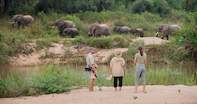
Kruger National Park
The grand old man of national parks is also the most affordable and accessible of Africa's major reserves. Its large size (equivalent to Wales) means it covers no fewer than 14 different ecosystems (including grasslands, woodlands, wetlands, granite outcrops, major rivers and deep ravines) and boasts the greatest species diversity of any park in Africa.
Kruger's exceptional range is reflected in seven three-day trails offered by Sanparks (South Africa's National Park authority). The walks are led by a park guide and require a reasonable level of fitness: up to 20km may be covered in a day, although the pace is kept deliberately leisurely to allow an intimate encounter with the wilderness.
Each trail has a base camp with four rustic two-bed huts, reed-walled showers and flush toilets. Meals are served in a covered dining area. The trails are so varied that the question isn't so much which one to do, but which one to do first: Bushman - secluded valley with great vantage points from granite kopjes reminiscent of Zimbabwe's Matobo Hills.
Bushman paintings in rock shelters. Metsi-Metsi - varied terrain: savannah, gorges, ravines. The Nwaswitsontso River attracts game, especially elephant. Napi - undulating terrain with luxuriant riverine bush. Notable for birdlife and high populations of both Black and White rhino. Nyalaland - extreme scenic beauty rather than big game. Dramatic vantage points, fever tree and baobab forests, the Lanner Gorge and numerous fossil sites.
Olifants - riverine bush and gorges alongside the Olifants River; varied wildlife.
Sweni - serious game viewing: classic Africa, with marula and knobthorn savannah. Wolhuter - A White rhino haven in the southern section of the park.
USP: Affordable and easily accessible.
Umfolozi Wilderness
The wild splendour of Umfolozi Wilderness befits a land that was once the private hunting ground of Shaka Zulu. The north is rugged and mountainous, with forests and grasslands; the south and west are more open, with undulating savannah.
The Big Five maintain a strong presence: in particular, Umfolozi is famed for its rhino concentrations (1600 white, 450 black). The Wilderness itself is contained within the Hluhluwe Umfolozi Park and is a 30,000ha haven where the only access is by foot or on horseback. There are no roads, just animal trails.
KZN Wildlife run guided 4-night walks into Umfolozi, along large rivers and through thorn savannah. There are two levels of walk: The Primitive Wilderness Trail reflects a basic bush-living ethos. Everyone leaves their watches behind, so modern time constraints are forgotten. Guests carry their own equipment in backpacks, sleep under the stars and drink stream water. A highlight is the night-watch shift, alone by the fire under the stars.
On the Traditional Trail, guests are more pampered, carrying just daypacks; donkeys transport the equipment to the fly-camp for the middle nights; the first and last nights are spent in a permanent camp. Without equipment to carry, trailists can cover up to 15km/day, depending on group fitness. USP: No roads or vehicles in Umfolozi Wilderness.
Tanzania
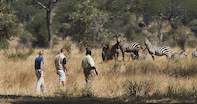
Selous
Walking Safari at Selous Sands River Camp
Africa's single largest game reserve (roughly 45,000km2) supports enormous numbers of animals: 30 000 elephant, 200 000 buffalo and significant populations of almost every other species of African mammal, including wild dog and Black rhino.
The brachystegia woodland sometimes makes walking exciting - you never know what's ahead. Of course the game roams a vast area, but this is serious wilderness, and bird- and wildlife along the Rufiji river are superb. With wooded hills, acacia thickets, palm groves, grasslands, lakes and marshes, the Selous offers an extremely pure walking experience.
The original walking safaris in the reserve are now run from the plush Sand Rivers camp overlooking the Rufiji in the southern Selous. Highly respected operator Richard Bonham began walking operations here in the 1980s; Sand Rivers took over two years ago and still use his original base camp. Two scheduled departures leave every month from June to October. Each portered walking trip lasts five nights, travelling between camps in the classic style of the earliest safaris.
Sand Rivers are happy to accommodate particular requests, such as longer walks (two to three weeks), special interests such as birding and family trips. The Selous Safari Company has recently launched a collection of group or private walking safaris, fly-camping in various parts of the reserve including dense riverside game areas a nd remote northern parklands. USP: Long walking trips, for total bush immersion.
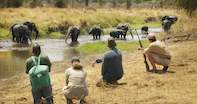
Tarangire National Park
Walking safari at Oliver's Camp Situated in the heart of Masailand, east of the Rift Valley, Tarangire has similar game to the Serengeti (large herds of plains game, especially wildebeest and zebra, plus abundant accompanying predators), although denser vegetation (acacia and mixed woodland) can make predators harder to spot.
The park is best between July and November, during the dry season when the herds make for water in the Tarangire River. Nearby are vast swamps, dense elephant grass, palms and baobabs. Raptors and acacia-associated birds are prolific.
You'll find a philosophical approach to walking safaris at Oliver's Camp, sited on an acacia-clad ridge overlooking Tarangire's swamp system: "To walk in the African bush is to return to our past and realise why we have the senses we have, and the brain-power to adapt and be curious... wildlife is encountered, but wildland is the point."
Walks of up to four days, with fly-camping, are adjusted to the clients' pace, with an emphasis on slowing down and not hiking for hiking's sake. As well as exploring Tarangire, walks venture along the Rift Valley or onto the Masai Steppe. Porters move the camp by vehicle, while guests walk up to 20km a day. USP: The Tarangire River acts as a dry-season wildlife magnet.
The Best of the Rest
Phinda (South Africa)
Phinda is Big Five country on the lush tropical KwaZulu Natal coast, with seven different ecosystems and 400 bird species. CCAfrica's ultra-luxurious Phinda lodge has recently launched three-night walking trails with fly-camping, accommodating up to eight people in four tents.
Tuli Safari Lodge (Botswana)
The lodge offers a new three- to four-night walking safari, based at a rustic tented camp on the banks of the Limpopo. The Tuli Block is game-rich, with flat mopane woodland, undulating bushveld, grassy savannah and sandstone outcrops. Walks are tailored to the interests of the group (up to six people).
Lower Zambezi NP (Zambia)
Clients walking with Vintage Africa Safaris in the Zambezi Escarpment hills enjoy 700km2 to themselves. Flexibility is key: clients discuss the following day's route with the guide each night. Lion, elephant and leopard roam the hills, while the Valley below offers the full range of Zambezi wildlife. Mobile camping, with mules carrying the equipment.
Chizarira National Park (Zimbabwe)
Leon Varley pioneered walking trails in this remote north-western corner of Zimbabwe and still leads personalised mobile foot safaris here. A popular alternative for families is Jedson's Camp, which caters for children, who can be entertained in camp by a childminder or taken on a walking experience of their own while parents stretch their legs in the bush.
Damaraland (Namibia)
Fly-camping on this community reserve means you're after one thing: rhino. The Save the Rhino Trust and Desert Adventure Safaris have teamed together to offer rhinophiles a chance to track their favourite beasts on foot (once you have driven to the creatures' vicinity). But don't worry if they prove elusive: the rust-red sands and endemic desert wildlife are worth experiencing in themselves.
Ngorongoro Crater (Tanzania)
Tropical Trekking lead a four-day walk along part of the Ngorongoro Crater rim, covering 10 -15km/day across open woodlands, grasslands and acacia forest. Highlights include vast views of the Crater and the Serengeti, a descent onto the Crater floor to view game and chance encounters with Maasai people living locally.
The Serengeti (Tanzania)
Celebrated for its dense predator populations and the annual wildebeest migration, the Serengeti is one of Africa's most hyped game reserves - and justifiably so. Nomad Safari Guides, founded by the renowned Mark Houldsworth, operate walking safaris from upwards of four days in the best corners of the park, at any season.
Copyright © 2004 Travel Africa Magazine.

 Footsteps Across The Delta host authentic Okavango Delta walking safari tours led by expert guides. Adventure safari travellers will revel i...
Footsteps Across The Delta host authentic Okavango Delta walking safari tours led by expert guides. Adventure safari travellers will revel i... Jongomero Tented Camp offers true African wilderness experiences in the remote African bush of Ruaha National Park, Tanzania. This is one of...
Jongomero Tented Camp offers true African wilderness experiences in the remote African bush of Ruaha National Park, Tanzania. This is one of...